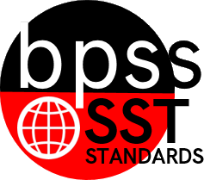MS Grade Standards
| All categories |
ECONOMICS |
|---|
SST-MS.E.01Middle School (SST) Social Studies
Economics Standard
SST-MS.E.01 Analyze the concept of scarcity when making economic decisions.Benchmarks
Guiding Practice
The guiding topics for each benchmark includes various subject matter that can be used to help students reach the standard. Calculation Method for StandardsStandards are larger groups of related benchmarks. So the Standard is a calculation of all the related benchmarks. So click on the benchmark identifier below each Standards to access the learning targets and proficiency scales for each standard. | |
SST-MS.E.02Middle School(SST) Social Studies
Economics Standard
SST-MS.E.02 Compare and contrast how varying economic systems impact a nation and its citizens.Benchmarks
Guiding Practice
The guiding topics for each benchmark includes various subject matter that can be used to help students reach the standard. Calculation Method for StandardsStandards are larger groups of related benchmarks. So the Standard is a calculation of all the related benchmarks. So click on the benchmark identifier below each Standards to access the learning targets and proficiency scales for each standard. | |
SST-MS.E.03Middle School (SST) Social Studies
Economics Standard
SST-MS.E.03 Analyze how supply and demand impact the allocation of goods and services.Benchmarks
Guiding Practice
The guiding topics for each benchmark includes various subject matter that can be used to help students reach the standard. Calculation Method for StandardsStandards are larger groups of related benchmarks. So the Standard is a calculation of all the related benchmarks. So click on the benchmark identifier below each Standards to access the learning targets and proficiency scales for each standard. | |
SST-MS.E.04Middle School (SST) Social Studies
Economics Standard
SST-MS.E.04 Analyze the various institutions that drive and support the market economy.Benchmarks
Guiding Practice
The guiding topics for each benchmark includes various subject matter that can be used to help students reach the standard. Calculation Method for StandardsStandards are larger groups of related benchmarks. So the Standard is a calculation of all the related benchmarks. So click on the benchmark identifier below each Standards to access the learning targets and proficiency scales for each standard. | |
SST-MS.E.05Middle School (SST) Social Studies
Economics Standard
SST-MS.E.05 Evaluate the various macroeconomic measurements available to determine an economy’s size and strength.Benchmarks
Guiding Practice
The guiding topics for each benchmark includes various subject matter that can be used to help students reach the standard. Calculation Method for StandardsStandards are larger groups of related benchmarks. So the Standard is a calculation of all the related benchmarks. So click on the benchmark identifier below each Standards to access the learning targets and proficiency scales for each standard. | |
SST-MS.E.06Middle School (SST) Social Studies
Economics Standard
SST-MS.E.06 Analyze how globalization has impacted various aspects of economies around the world.Benchmarks
Guiding Practice
The guiding topics for each benchmark includes various subject matter that can be used to help students reach the standard. Calculation Method for StandardsStandards are larger groups of related benchmarks. So the Standard is a calculation of all the related benchmarks. So click on the benchmark identifier below each Standards to access the learning targets and proficiency scales for each standard. | |
SST-MS.E.07Middle School (SST) Social Studies
Economics Standard
SST-MS.E.07 Evaluate the elements of responsible personal finance.Benchmarks
Guiding Practice
The guiding topics for each benchmark includes various subject matter that can be used to help students reach the standard. Calculation Method for StandardsStandards are larger groups of related benchmarks. So the Standard is a calculation of all the related benchmarks. So click on the benchmark identifier below each Standards to access the learning targets and proficiency scales for each standard. | |
GEOGRAPHY |
|---|
SST-MS.G
6-8 Social StudiesGeography DomainStandards
DescriptionThese geography standards are based on the Five Themes of Geography: Place, Movement, Regions, Location, and Human-Environment Interaction. These standards are written to give students a global perspective, which they can apply to other courses of study. Quality geography education is more than memorizing places on a map. It involves an understanding of various cultures, their motivations, and their connections to the global community. It also includes a deep understanding of how human beings have altered the landscape of the Earth over time, both physically and culturally. Calculation Method for DomainsDomains are larger groups of related Standards with benchmarks. So the Domain is a calculation of all the related standards that calculate to the benchmarks. So click on the benchmark identifier below each Standards to access the learning targets and proficiency scales for each standard. | |
SST-MS.G.01Middle School (SST) Social Studies
Geography Standard
SST-MS.G.01 Describe the physical processes that shape the Earth’s surface and how these affect the lives of people who live there.Benchmarks
Guiding Practice
The guiding topics for each benchmark includes various subject matter that can be used to help students reach the standard. Calculation Method for StandardsStandards are larger groups of related benchmarks. So the Standard is a calculation of all the related benchmarks. So click on the benchmark identifier below each Standards to access the learning targets and proficiency scales for each standard. | |





